Utilizing biomarkers associated with cardiovascular events in atrial fibrillation: informing a precision medicine response
IF 1.2
Q4 PHARMACOLOGY & PHARMACY
Expert Review of Precision Medicine and Drug Development
Pub Date : 2020-08-03
DOI:10.1080/23808993.2020.1804864
引用次数: 0
Abstract
ABSTRACT Introduction Atrial fibrillation is the most common sustained cardiac rhythm disorder, which currently affects 1–2% of the global population. Furthermore, the incidence and prevalence of atrial fibrillation is rising. Biomarkers have the potential to improve clinical management of patients and therefore reduce the burden on health systems in the future. Areas covered A variety of pathways and mechanisms have been associated with atrial fibrillation. This paper provides an overview of a range of blood-based, imaging and genetic biomarkers that are associated with mechanisms and outcomes in atrial fibrillation and their potential use in a clinical setting. Expert commentary Atrial fibrillation is becoming increasingly prevalent. Current biomarkers associated with atrial fibrillation such as those involved in myocardial stress, inflammation, hemostasis and fibrosis do not currently provide much additional practical value beyond recommended scores based only on clinical risk factors.利用与心房颤动心血管事件相关的生物标志物:告知精准医学反应
心房颤动是最常见的持续性心律失常,目前影响全球1-2%的人口。此外,房颤的发病率和患病率正在上升。生物标志物有可能改善患者的临床管理,从而在未来减轻卫生系统的负担。心房颤动涉及多种途径和机制。本文概述了一系列与心房颤动的机制和结果相关的血液、成像和遗传生物标志物及其在临床环境中的潜在应用。专家评论房颤越来越普遍。目前与房颤相关的生物标志物,如那些涉及心肌应激、炎症、止血和纤维化的生物标志物,除了仅基于临床危险因素的推荐评分外,目前并没有提供太多额外的实用价值。
本文章由计算机程序翻译,如有差异,请以英文原文为准。
求助全文
约1分钟内获得全文
求助全文
来源期刊

Expert Review of Precision Medicine and Drug Development
PHARMACOLOGY & PHARMACY-
CiteScore
2.30
自引率
0.00%
发文量
9
期刊介绍:
Expert Review of Precision Medicine and Drug Development publishes primarily review articles covering the development and clinical application of medicine to be used in a personalized therapy setting; in addition, the journal also publishes original research and commentary-style articles. In an era where medicine is recognizing that a one-size-fits-all approach is not always appropriate, it has become necessary to identify patients responsive to treatments and treat patient populations using a tailored approach. Areas covered include: Development and application of drugs targeted to specific genotypes and populations, as well as advanced diagnostic technologies and significant biomarkers that aid in this. Clinical trials and case studies within personalized therapy and drug development. Screening, prediction and prevention of disease, prediction of adverse events, treatment monitoring, effects of metabolomics and microbiomics on treatment. Secondary population research, genome-wide association studies, disease–gene association studies, personal genome technologies. Ethical and cost–benefit issues, the impact to healthcare and business infrastructure, and regulatory issues.
 求助内容:
求助内容: 应助结果提醒方式:
应助结果提醒方式:


